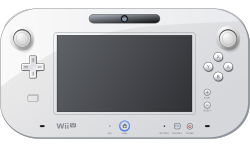Wii U GamePad

Illustration of the Wii U GamePad
|
|
| Developer | Nintendo |
|---|---|
| Type | Video game controller |
| Display | 6.2 inch (15.7 cm) 854x480 (FWVGA) 16:9 @ 158 ppi |
| Sound | Stereo speakers, Headphones |
| Input |
|
| Camera | 1.3 MP Front-facing camera |
| Touchpad | Single-touch LCD display |
| Connectivity | Proprietary wireless based on IEEE 802.11n,NFC, Infrared |
| Power |
LiPo 3.7 V DC 1500 mAh (WUP-012; 3-5 hours use) LiPo 3.6 V DC 2550 mAh (upgrade WUP-013; 8 hours use) |
| Dimensions | 5.3 in × 0.9 in × 10.2 in (13.5 cm × 2.3 cm × 25.9 cm) |
| Weight | 491 g |
| Predecessor | Wii Remote |
The Wii U GamePad is the standard controller for Nintendo's Wii U video game console. Incorporating traits from tablet computers, the GamePad has traditional input methods (such as buttons, dual analog sticks, and a D-pad), touchscreen controls, and motion controls. The touchscreen can be used to supplement a game by providing alternate, second screen functionality or an asymmetric view of a scenario in a game. The screen can also be used to play a game strictly on the GamePad screen, without the use of a television display. Conversely, non-gaming functions can be assigned to it as well, such as using it as a television remote.
The Wii U GamePad can be used in conjunction with other controllers compatible with the console, such as the Wii Remote Plus, Wii Balance Board, and the more conventional Wii U Pro Controller.
During development of the Wii console, video game designer Shigeru Miyamoto brought in mobile phones and controllers for automotive navigation systems for inspiration for the Wii Remote, eventually producing a prototype that resembled a cell phone. Another design featured both an analog stick and a touchscreen, but Nintendo rejected the idea of a touchscreen on the controller, "since the portable console and living-room console would have been exactly the same".
Nintendo's development team had determined that the Wii's notification light did not provide enough information to be useful beyond whether it had received content or not. With the complexity of modern televisions, Miyamoto believed that a monitor separate from the console would provide an easier way to check on the console's status without needing to use the television. Its operation as a supplemental display was also inspired by the common use of a similar display at karaoke establishments in Japan, which displays song information and also allows its users to select their next song.
...
Wikipedia
